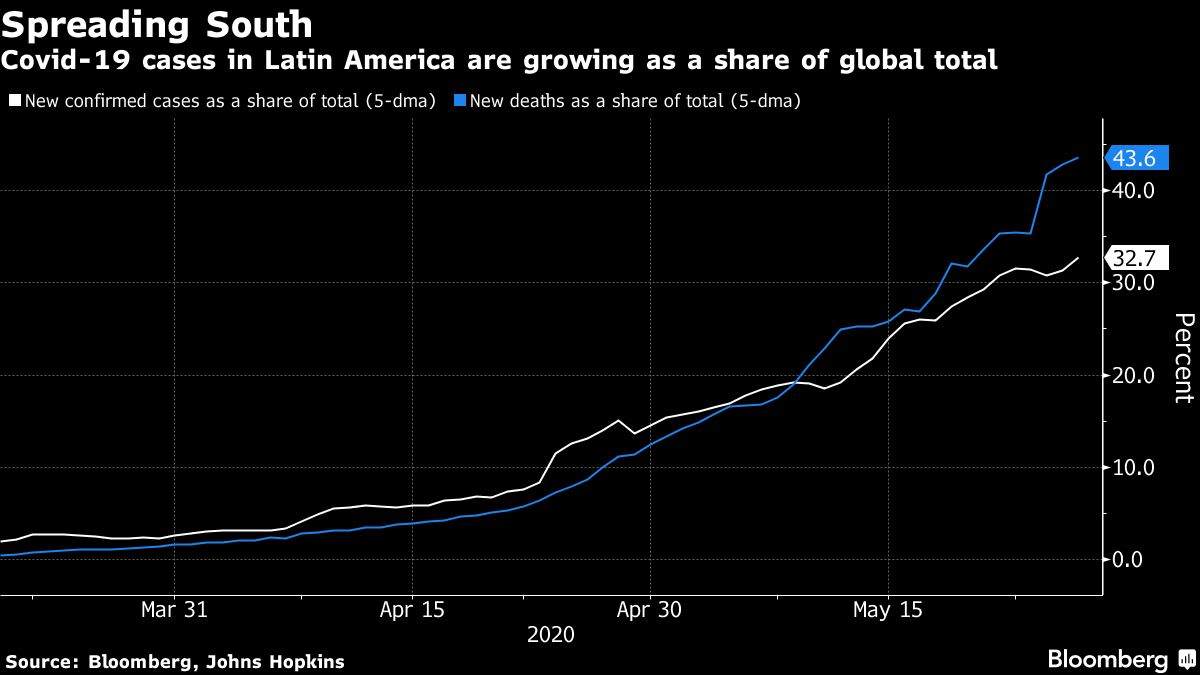
(Bloomberg) -- In March, when Covid-19 was stamping out lives across the globe, Latin America looked like it might escape relatively unharmed. Its governments chose vastly different approaches to confronting the pandemic, from severe lockdown in El Salvador and Peru to relative laxness in Brazil and Mexico.
But as May heads into June, the news could hardly be more dire for the highly urbanized region of 600 million inhabitants -- or about 8% of the world’s population. It is, without question, the new epicenter of coronavirus, representing about 40% of daily deaths globally now.
The statistics are chilling: Brazil has more cases than any country except the U.S. and some models forecast that deaths, currently at 25,000, could more than quadruple in coming months. Mexico had its largest single increase in both cases and deaths this week and a top health official said about 30,000 people may die. Peru, Chile and Colombia have all set daily records in the past week.
Latin American countries reported more than 1,900 deaths on Wednesday, a record, accounting for 37% worldwide. Brazil, Peru, Chile and Mexico have each reported more than 10,000 new cases in the past five days, making them four of the top seven countries globally in that period.
“Many of the region’s largest cities are still several weeks away from their peaks,” said James Bosworth, author of the weekly newsletter Latin America Risk Report. “Hospitals will run at capacity for a long time, straining the healthcare systems. Even those cities and countries that do peak will see a multi-week plateau and a gradual descent rather than a sharp drop in cases.”
Complicating the assessment of the situation -- like in many parts of the world -- is the dearth of data and the fact that forecasting and modeling rates of infection and death have often proven unreliable.
Chile, a country of 18 million, has tested more people than Mexico, which has 127 million inhabitants. Many who have died at home untested aren’t registered as related to Covid-19. But one way to measure the virus’s impact is to compare mortality rates with previous years. A report in Mexico City this week found four times more deaths so far in 2020 than over the past four years.
A number of Latin American countries dutifully tried to shut themselves down early but often without enough state aid for the many millions who work in the informal economy. And quarantines have been patchy. Outdoor markets where many people buy their food, remained open in some places. To get government aid, recipients who don’t have bank accounts have often had to line up in tight formation, further spreading the virus.
An additional concern is that, across the region, some normal activity is resuming even as caseloads continue to explode. Without more government aid and security forces, many countries may not be able to sustain quarantines until the worst of the storm has passed.
In Brazil, a growing political crisis has further complicated efforts. Far-right President Jair Bolsonaro has bickered publicly with state governors imposing restrictions on movement and manufacturing. Bolsonaro’s dislike of social distancing measures and passion for chloroquine have cost him two health ministers since the pandemic struck. The post is currently vacant.
In Mexico, President Andres Manuel Lopez Obrador has also downplayed the need to shut down the economy in order to slow the spread of the virus and began pushing for a reopening weeks ago. He said he plans to resume his trips to smaller cities outside of the capital as early as next week where he frequently embraces fervent supporters of all ages.
The region is expected to contract 5.2% this year, the deepest recession in 50 years, according to the International Monetary Fund. About 40% of jobs are in the informal economy, the IMF said in a report last month.
Latin America has a sophisticated elite whose members appear to have been the first infectors as they returned from skiing in Colorado and Carnival celebrations in Italy.
But it also has an enormous underclass who live often in primitive conditions far from decent hospitals. It is those segments of the populations, some of whom live in close quarters without clean water, that are now burning with infection.
The nightmare scenario some feared would come to pass in Syria or India appears to be unfolding in Brazil.
This week, Brazil recorded daily death figures outpacing the U.S., the global epicenter, and will likely surpass fatality numbers in Spain and France within a week. Neighboring countries like Paraguay, Uruguay and Colombia have closed borders to Brazil and the U.S. imposed a travel ban this week.
A UBS report published on Wednesday said that six of Brazil’s 27 states are peaking while total deaths are increasing in 21 states. There’s no sign of any peak in Mexico yet, the analysts wrote.
(Adds Chile record to table, background on regional leaders.)
For more articles like this, please visit us at bloomberg.com
©2020 Bloomberg L.P.